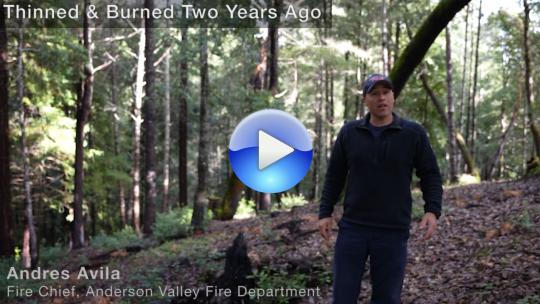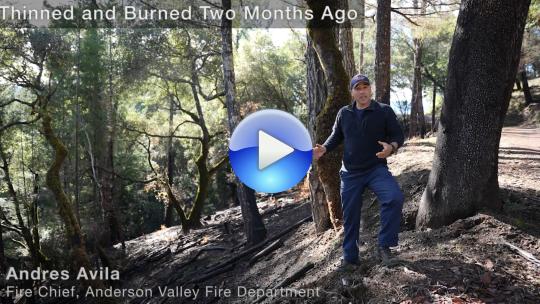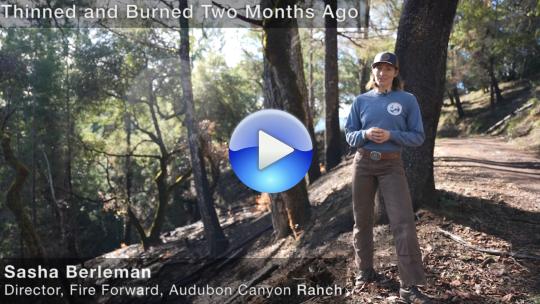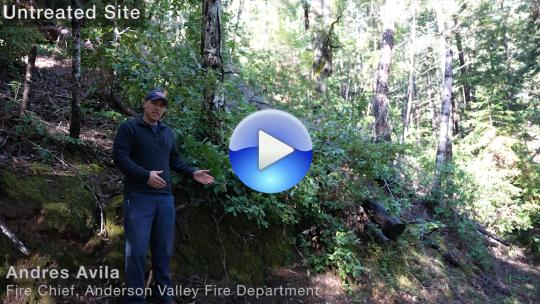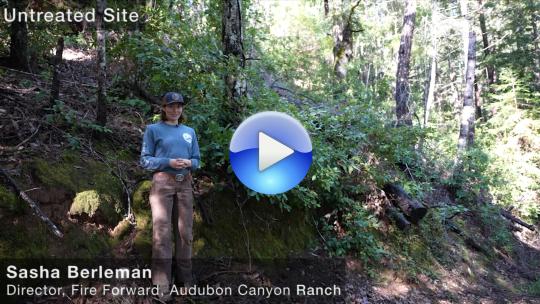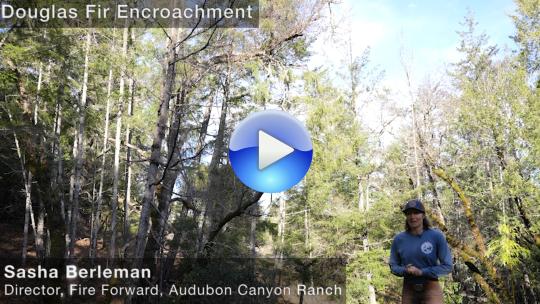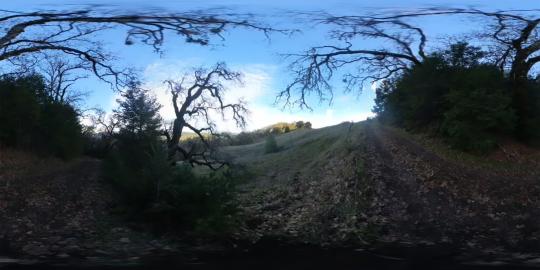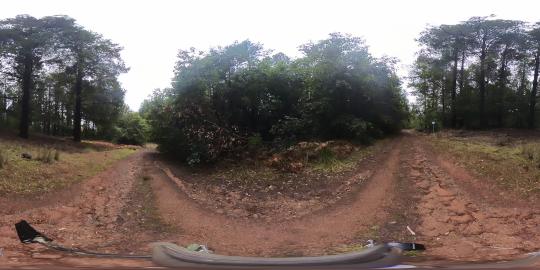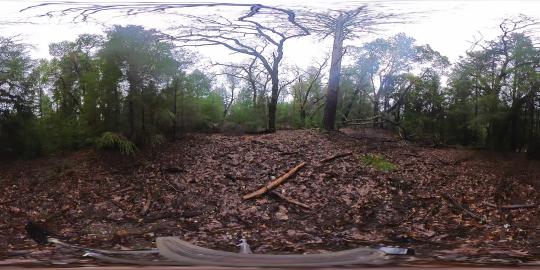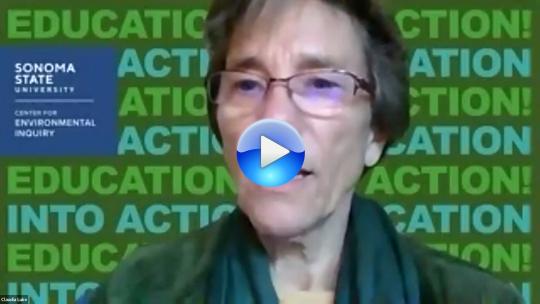Good Fire Series: Reading Fire on the Land
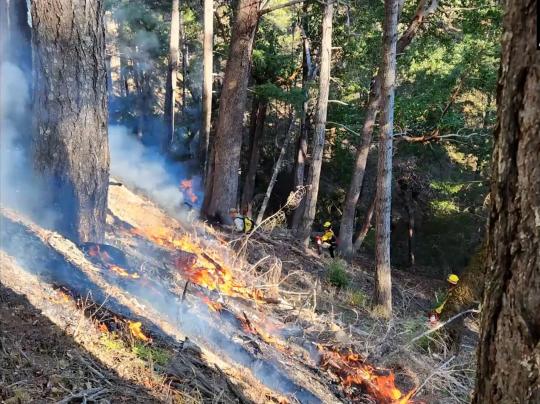
Welcome to this interactive web page that helps you learn about the role of fire in ecosystems!
With experts as your guides, we teach you to find the clues that tell you the story of a site's fire history, its resilience, and its susceptibility to future fires. These skills will help you make predictions about the benefits and challenges of reintroducing fire to your California landscape.
A Brief Background on Prescribed Fire
Controlled burning has deep historical roots in many regions of the United States, where native peoples engaged the practice. Cultural burns were carefully timed to enhance ecosystem health and sustain traditional lifeways.
With the arrival of European settlers and genocide of Indigenous peoples, fire as a tool for managing healthy ecosystems was largely removed from western landscapes. Europeans saw Wildfire primarily as a destructive force, and widespread policies and advertising (such as the US Forest Service's Smokey the Bear campaign) focused on preventing and extinguishing fire.
Now, decades later, we face the detrimental effects of these 20th century "no burn" policies: the buildup of dense vegetation and dead wood fuels hotter, bigger fires, and the lack of frequent, cooler fires have caused a decline in biodiversity and other measures of ecosystem health.
Today, there is renewed recognition of prescribed fire as a tool for ecological restoration and fire safety. Land managers – from students to private landowners to national foresters – are seeking to understand how to plan and execute prescribed fire to enhance safety and ecosystem resilience. Yet, fire behavior, timing, and impacts vary widely across landscapes. One-size-fits-all approaches are ineffective or even harmful. Prescribed fire is most effective when tailored to the specific ecological conditions, vegetation types, and cultural contexts of a given area. Local knowledge is critical for understanding when, where, and how to burn safely and beneficially. By grounding prescribed fire in place-based knowledge and site-specific goals, land managers can support ecosystem health, reduce wildfire risk, and restore natural fire cycles in ways that are both effective and culturally appropriate.
Course Intro: BUILDING YOUR SKILLS
In this interactive virtual session, we start you on a journey to learn how to read landscapes and assess whether fire could improve the safety or health of ecosystems. Hosted by Center for Environmental Inquiry Director Dr. Claudia Luke, we explore two highly inter-related aspects of prescribed burn goals with leading experts:
- Fire Behavior: with Anderson Valley Volunteer Fire Department Chief, Andres Avila
- Fire Ecology: with Fire Forward, Audubon Canyon Ranch, Director, Dr. Sasha Berleman
In this training (< 60 min), we will lead you through a four-step exercise:
- Part 1. INTRODUCTION TO FIRE ECOLOGY AND FIRE BEHAVIOR: Listen to a brief introduction from each expert to get you grounded in some of the basic concepts
- Part 2: FIELD TRIPS: Go with the experts into the field to view sites with various exposure to fire
- Part 3: PRACTICE YOUR SKILLS: Check out the 360 images of new sites, and use them to practice finding evidence of burn history, ecosystem resilience, and fire risk. Compare your answers with evaluations from the experts.
- Part 4: Q&A WITH EXPERTS: Watch the Q&A video, in which experts answer questions from the audience
Part 1. INTRODUCTION TO FIRE ECOLOGY AND FIRE BEHAVIOR
Let's start here with two brief introductions by Dr. Sasha Berleman and Chief Andres Avila to fire ecology and fire behavior in California landscapes.
Summary of 8-min Video
In this video, Dr. Sasha Berleman discusses fire's critical role in California’s ecosystems. The state’s oak woodlands, redwoods, and coastal prairies are fire-adapted, and plants have evolved various strategies to survive or even rely on fire, including thick bark, re-sprouting, and serotinous cones that only release seeds after fire.
Fire suppression and colonization have led to ecological imbalances. Grasslands of native bunchgrasses and wildflowers are now overtaken by invasive European grasses that create dense mats of dry thatch, increasing fire risk and reducing biodiversity. The coastal prairie—North America’s most diverse grassland ecosystem—has declined to just 5% of its historic range, leading to encroachment by coyote brush and Douglas-fir.
Restoration efforts that reintroduce fire—along with mechanical treatments—can successfully reopen and revitalize these disappearing ecosystems.
Summary of 11-min video
Chief Andres Avila gives an overview of wildfire behavior, and the effectiveness of prescribed burns, when applied under the right conditions, using the proper tools and strategies. He also shares examples of prescribed burns across different habitats.
Fire behavior is influenced by three factors – also called the fire behavior triangle: fuels (the amount, type, and dryness of vegetation), topography (such as slopes, canyons, or flatlands), and weather (including wind, temperature, humidity, and recent precipitation).
Chief Avila emphasizes the importance of expertise and planning, urging people to not attempt burns on their own and to fully understand the specific conditions of their land. He also highlights the value of community education and involving youth in fire stewardship to reduce fear and build a more knowledgeable, resilient relationship with fire.
Part 2. FIELD TRIPS: Site #1 - Thinned and Burned 2 Years Ago
We first visit a site in Mendocino County that was burned two years ago. Your guides, Dr. Berleman and Chief Avila, show you the various types of clues they use to decipher why the forest looks like it does and how it is functioning.
Summary of 2:30-min Video
Chief Andres Avila identifies the evidence that this site burned recently:
Lack of ground fuels: He notes there's very little leaf litter or debris on the forest floor—just "one handful of leaves and then I'm at the dirt." This suggests that surface fuels were recently consumed, likely by fire.
Absence of ladder fuels and fine fuels: He mentions a lack of small branches, shrubs, or other "ladder fuels" between the ground and the tree canopy, which are typically present unless they've been removed—often by fire.
Condition of vegetation: He refers to small tanoak sprouts that would be targeted in a prescribed burn and describes how they would look after burning—implying similar conditions may already be visible, supporting recent burning.
Chief Avila notes the following key fire behavior factors:
Fuel Load – The amount of combustible material on the ground (e.g., leaf litter, logs, small vegetation).
Fuel Continuity – Whether fuels are continuous enough to allow fire to spread from the ground to the canopy.
Ladder Fuels – Presence or absence of vegetation (like low limbs or small trees) that can carry fire into the canopy.
Tree Density – The spacing between trees, which influences how fire moves across the landscape.
Topography – The slope and shape of the land, which affects fire spread and intensity.
Wind – A major driver in how quickly and intensely a fire can grow or move.
Weather Conditions – Including moisture levels, whether it’s a dry or rainy day, and overall burn conditions.
Fuel Moisture – The dryness or wetness of fuels (e.g., crunchy vs. damp leaf litter), which impacts ignitability and heat production.
Fuel Type – Particularly the role of "1-hour fuels" (fine fuels like leaves and twigs) that ignite easily and influence fire intensity.
These factors collectively determine whether fire behavior will be intense and fast-moving or more controlled and manageable. Conditions at this site predict that a fire would be manageable.
Summary of 2:22-min Video
Dr. Berleman provides the following evidence that this site burned about two years ago:
She explores the forest health advantages of an open forest structure that has adequate space between trees, an open understory, and a thin layer of duff. These ecological benefits reflect not only good stewardship but also align with long-standing practices of Indigenous peoples, who have tended California’s landscapes for millennia.
Reduced competition - When plants aren’t overcrowded, they can more easily access essential resources like sunlight and water. This reduces competition for these resources (especially during drought) and lowers stress on both trees and understory vegetation.
Healthy understory structure – An open understory with low resprouts (below knee height) allows a greater diversity of herbaceous plants to thrive
Reduced disease spread – Healthy, well-spaced forests are less vulnerable to pathogens.
Dr. Berleman emphasizes that these ecosystems are adapted to the presence of people and fire, and they thrive when traditional forms of care—like cultural burning—are restored and continued. She discusses how the current conditions make further on-going management easier:
Thin Duff and litter layers – A very thin duff and litter layer are evidence of recent fire and low fuel accumulation, creating good conditions for future prescribed burns.
Reduced wildfire behavior – Lower fuel loads and open structure reduce the intensity and spread potential of wildfire.
Part 2. FIELD TRIPS: Site #2 - Thinned & Burned Two Months Ago
Next we visit a site in Mendocino County that was burned two months ago. What evidence can we see of impact of the burn on fuel reduction and ecosystem function?
What evidence does Chief Avila see that the site was burned two months ago?
The most visible evidence is extensive black charring on the landscape and charred tree trunks, indicating recent fire activity.
There are partially burned large logs that remain on the ground, showing that the fire was recent but didn’t consume all available fuels.
Scorch marks on trees are visible but did not penetrate deeply into the hardwoods or enter existing wounds ("goose pens"), suggesting a controlled, low-intensity burn.
What were the starting conditions?
The area had dense surface fuels, especially fine fuels like straw-sized debris, which could have produced damaging heat in a summer wildfire scenario.
The site also featured a steep slope, which can increase fire intensity and rate of spread.
How was the site treated?
The site had been treated with a lop-and-scatter method in 2019, meaning cut vegetation was left on the ground, creating a significant surface fuel load.
A prescribed burn was conducted in November, during a cooler, moist season to reduce risk.
The burn targeted small to medium-sized fuels (roughly straw-sized to 1-inch diameter), which were effectively consumed.
The larger logs retained moisture and did not fully ignite, which was acceptable and even beneficial for ecological balance.
Fire was applied in a slow, methodical manner, with careful attention to avoiding damage to live trees, especially avoiding fire climbing into mossy trunks or tree wounds.
What was the outcome?
The burn successfully reduced surface fuels while protecting the health of standing trees.
Although not all material was consumed, the outcome met the landowner’s goals and demonstrated effective fuel management on a challenging site.
The site is now safer and more resilient to wildfire, and may or may not need future treatment, depending on the landowner’s management goals.
Chief Avila emphasizes that this burn would have been far more intense and dangerous if done in August, highlighting the importance of burning during safe seasonal windows.
What evidence does Dr. Berleman see that the site was burned two months ago?
There is extensive char and blackened ground, indicating recent fire activity.
The forest has lost much of its visible green vegetation, which is typical soon after a burn.
This appearance—blackened soil and minimal ground cover—is described as typical for a recently burned woodland or mixed evergreen forest.
What is desirable about this condition?
The char represents stable carbon being returned to the soil, enriching it over time.
Nutrients have been released and made available for new plant growth.
The site now supports a mosaic structure, which increases ecological diversity and resilience.
Partially burned logs remain on the ground, which are ecologically beneficial—they help slow water movement across the slope, reduce erosion, and retain moisture in the soil. These logs also contribute additional stable carbon as they decompose over time.
The site is ready for regeneration with a higher diversity of herbaceous plants, which is a desired ecological outcome.
What evidence can you see of recovery?
New green growth is beginning to emerge, especially in the form of herbaceous plants on the forest floor.
The recovering understory shows signs of increased plant diversity, a positive ecological response.
Fire-adapted trees are showing appropriate responses—species like redwoods benefit from charring on their trunks due to their natural insulation, while others are adapted to low-intensity burns and are unaffected by the recent fire.
Part 2. FIELD TRIPS: Site #3 - Untreated
Next we visit a site in Mendocino County that has not been treated. What evidence can we see that the site has not burned for a long time and what are the impacts on the forest?
Summary of 2:03-min Video
What evidence does Chief Avila notice that the site has not been treated?
High fuel density: There is a large amount of small, dry surface fuels—from ground litter to dead limbs—that can easily ignite.
Downed trees and debris: A fallen drone tree took down others with it, contributing significantly to the buildup of dead and dry fuels.
Steep terrain: The site’s slope makes mechanized firefighting difficult or impossible, limiting suppression to hand tools.
Ladder fuels: Fuels that could carry fire from the ground into the tree canopy are present, increasing the risk of crown fire.
Visual contrast: In a nearby area treated by hand (not with fire), there is much better visibility and fewer ladder fuels, showing a positive example of treatment outcomes.
How would fire behave on this site?
Without treatment, a fire in this area would be high-intensity, hard to control, and dangerous for firefighters—potentially unreachable and unmanageable due to fuel load and terrain.
With pre-treatment, fuels could be safely reduced by hand, especially surface and ladder fuels, lowering the risk of a fire becoming severe or spreading uncontrollably, and allowing a prescribed burn to proceed.
The treated area nearby serves as a model: though still holding some fuel, its reduced ladder fuels make it a strong candidate for prescribed fire to further reduce risk and enhance forest resilience.
In essence, Chief Avila uses the site as a teaching example of how hazardous conditions can escalate wildfire risk—and how pretreatment that reduces fuel loads (by hand) can allow a prescribed burn to proceed is a proactive solution to make future fire management safer and more effective.
Summary of 2:21-min Video
What evidence does Dr. Berleman see that the site has not been treated?
High density of vegetation: There is an abundance of both growing and non-growing plant material.
Tall resprouts and seedlings, particularly a large number of young Douglas-firs, dominate the understory.
The lack of recent fire or management has led to unchecked growth and dense fuel buildup.
An old madrone tree has fallen, suggesting declining health of long-standing hardwoods due to competition and stress.
What are the drawbacks of this condition?
Overcrowding by young Douglas-firs is suppressing older hardwood trees and reducing overall forest diversity.
Hardwoods are beginning to die off, overtopped and shaded by the dense growth of Douglas-firs.
There is a build-up of surface fuels, increasing the risk of high-intensity wildfire.
The number and diversity of understory plants (forbs, flowering species, berry-producing plants) is declining.
The forest in this state is less resilient to drought, pathogens, and wildfire due to reduced structural and species diversity.
What are the advantages of this condition?
Despite the problems, this dense, untreated structure can provide habitat value for certain species, particularly in small, scattered patches.
Dr. Berleman notes that some pockets of this structure are useful, but the issue is that it has become too widespread across Northern California forests, reducing the overall ecological resilience of the landscape.
In conclusion, Dr. Berleman emphasizes that while this kind of dense growth can serve ecological functions in moderation, widespread lack of management leads to declining forest health, biodiversity loss, and increased vulnerability. The goal is to restore a mosaic landscape with varied structure, species, and treatment history to promote long-term resilience.
Part 2. FIELD TRIPS: Sites #4 AND #5 - Evidence of Encroachment
We join Dr. Berleman at two sites to explore what evidence of encroachment looks like.
Summary of 0:43-min Video
Dr. Sasha Berleman identifies several key pieces of evidence of encroachment in coastal prairie ecosystems:
Presence of coyote brush: She points out that coyote brush is beginning to invade the coastal prairie, which is a common early sign of woody plant encroachment.
Followed by Douglas-fir: Over time, if left unmanaged, Douglas-fir trees also begin to establish and spread into the coyote brush, further displacing native grassland species.
Loss of open grassland structure: This encroachment shifts the ecosystem away from its original open, grassy composition toward a denser, shrubby or forested state.
Dr. Berleman emphasizes that coastal prairie is a disturbance-dependent ecosystem, relying on regular events like grazing or fire to maintain its structure and diversity. The removal of these disturbances allows woody species like coyote brush and Douglas-fir to take hold, leading to the decline of North America’s most diverse grassland ecosystem, of which less than 5% remains today.
Summary of 1:11-min Video
Dr. Sasha Berleman observes several clear signs of Douglas-fir encroachment in the oak woodland ecosystem:
Young Douglas-firs growing straight up through the canopy of older black oaks and madrones, indicating they are piercing through and overtopping the native hardwoods.
Struggling oaks, whose moss-covered, arching branches contrast with the vertical, vigorous growth of the Douglas-firs, show signs of stress as they lose access to sunlight and space.
A visible shift in forest structure, where continued Douglas-fir dominance would eventually convert the diverse woodland into a single-age stand of Douglas-fir.
Dr. Berleman warns that this encroachment leads to a decline in biodiversity, reduced ecosystem health, and a loss of ecosystem services—such as wildlife habitat, water retention, and cultural values—that oaks and other native species typically provide.
Part 3. PRACTICE YOUR SKILLS - Try It Yourself
Here's your chance to play expert and evaluate habitats for prescribed burning and forest health. Take a look at these 360 images representing the various scenarios talked about in the videos above.
Click on each image to open. The image may appear blurry until it is fully downloaded. Then click the full-screen icon to expand, and use your mouse, mouse pad, or touchscreen to explore the 360 panorama. (If you would like to compare your observations and predictions with Dr. Berleman and Chief Avila's recommendations in the next section, use the last image on the second row to conduct your evaluation.)
Exercise: What kind of management would you recommend for each site? Develop your prescription by first listing your observations:
- Evidence of fire history
- Factors you can see related to forest resilience
- Factors you can see that could affect fire behavior
Once you have listed your observations, provide a recommendation for introducing fire to the landscape, and identify what your goals would be.
Part 4. Q&A WITH EXPERTS
CEI Director Claudia Luke fields questions from the audience with Chief Andres Avila & Dr. Sasha Berleman.
Summary of 21-min Video
Dr. Berleman and Chief Avila answer the following questions from the audience:
Prescribed Burning & Treatment Timing
What’s the benefit of doing a prescribed burn first and thinning afterward?
Can you do a cool prescribed burn in a stand full of ladder fuels before thinning?
Treatment Approaches and Concerns
What about an area that was lopped and scattered a few years ago where limbs were left on the ground for mulch and erosion control? Can it still be burned safely on steep terrain?
What recommendations do you have for burning blackberry and willow in seasonally wet areas? What conditions should we look for?
Has fire been used successfully to remove Scotch broom?
Encroachment and Forest Health
How can we educate landowners who are allowing Douglas-firs to grow—and even planting them—in naturally oak woodland areas?
What are effective strategies for teaching people about Douglas-fir encroachment and its impact on oak woodlands?
Post-Wildfire Recovery
In areas affected by the 2020 Walbridge Fire, where trees have since blown down and new growth is emerging, what are the considerations for using fire again?
How should landowners manage large fuels and invasive plants like broom in the aftermath of a high-intensity wildfire?




